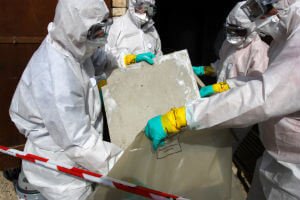Blog
Who is at Risk for Secondhand Asbestos Exposure?
Posted on behalf of Peter T. Nicholl in Mesothelioma & Asbestos Published on November 13, 2019 and updated on March 7, 2022. Asbestos exposure has resulted in the deaths of thousands of people in the U.S. after developing incurable diseases from this deadly toxin. While many mesothelioma cases are due to primary exposure to asbestos in the workplace, many other victims of this disease developed it because of secondhand asbestos exposure, which can still lead to mesothelioma and other asbestos-related diseases.
Asbestos exposure has resulted in the deaths of thousands of people in the U.S. after developing incurable diseases from this deadly toxin. While many mesothelioma cases are due to primary exposure to asbestos in the workplace, many other victims of this disease developed it because of secondhand asbestos exposure, which can still lead to mesothelioma and other asbestos-related diseases.
The experienced lawyers at Peter T. Nicholl Law Offices further explain secondhand asbestos exposure, those most at-risk, and what your legal options are for recovering compensation due to this exposure.
What is Secondary Asbestos Exposure?
Secondary asbestos exposure is a type of non-occupational exposure to toxic asbestos fibers. While primary asbestos exposure usually occurs in the workplace, secondary asbestos exposure comes from exposure to asbestos usually brought home by a person who was exposed to asbestos in the workplace. The worker brings home asbestos dust or fibers where other people in the home breathe in these dangerous toxins.
While secondhand asbestos exposure is not as common as it used to be decades ago because of current federal safety regulations in place, there are still some reported incidences of it. Secondhand asbestos exposure is just as dangerous as primary asbestos exposure and can lead to mesothelioma and other serious diseases when the exposure is prolonged and repeated.
The time between first being exposed to asbestos and being diagnosed with mesothelioma is generally between 20 to 50 years. Because of this long period of time, many cases of secondhand asbestos exposure have yet to be identified.
Sources That Can Lead to Exposure
Asbestos was used in a variety of products before the 1980s. It was a good insulator, so it was often used to construct buildings and wrap around machinery and boilers. Employees and consumers did not know about the risks of asbestos exposure for many years after these products were widely sold in the U.S.
Many workers were in contact or around asbestos without being informed of the possible risks of working with this material. These workers brought home microscopic particles on their clothing and on their person. Loved ones who had contact with the worker were exposed to the same asbestos dust and fibers the worker was exposed to at work.
Asbestos particles are friable. They often break off and become airborne where they can then float onto workers’ clothing, hair and skin. Anything that the worker comes into contact with while carrying these deadly fibers can become a potential source of secondary exposure.
Common sources of secondhand asbestos exposure include:
- Laundry – Workers who handled asbestos products often carried asbestos dust and fibers home on their clothing. The person who laundered the worker’s clothes was at risk of breathing in these harmful contaminants.
- Furniture – Workers who did not immediately change out of their asbestos-exposed clothing could have transferred asbestos fibers to furniture in their home, such as couches, chairs, beds and other pieces of furniture. Other people who resided in the home could then have been in contact with these fibers.
- Vehicles – If the worker did not change out of contaminated clothing before entering his or her vehicle to travel home, asbestos fibers could adhere to the seats or carpet in their vehicle. Family members could then be exposed to asbestos when riding in the vehicle.
Individuals Most at Risk for Secondhand Exposure
Anyone who lived with someone who was exposed to asbestos at work is at risk for secondhand exposure.
Additionally, research indicates that women are at an elevated risk of secondhand asbestos exposure. Most asbestos exposure occurred prior to the 1980s before it was banned in most forms. During that era, males made up the majority of the workforce handling asbestos-containing products. Workers who returned home to greet their spouses with a hug or other personal contact could have caused a transfer of asbestos dust or fibers.
Children who helped with household chores or who were exposed to asbestos in the home are also at risk for developing mesothelioma and other asbestos-related diseases.
Liability in Secondary Exposure Cases
Individuals who were exposed to secondhand asbestos may have a legal basis for recovering compensation for damages that they sustain due to this exposure. However, they must be able to trace their exposure to a particular defendant who made a product that contained asbestos and who failed to warn or protect against the dangers of asbestos.
Schedule a Free Consultation
It is often very difficult to establish liability for secondhand asbestos exposure. It is important that you have the help of a Maryland mesothelioma and asbestos disease lawyer who can help you identify the parties responsible for your exposure and pursue a claim on your behalf.
Contact us today to schedule a free consultation at no obligation. There are no upfront fees unless we help you recover compensation.
There is no risk in calling us. Ph: 410-244-7005.

